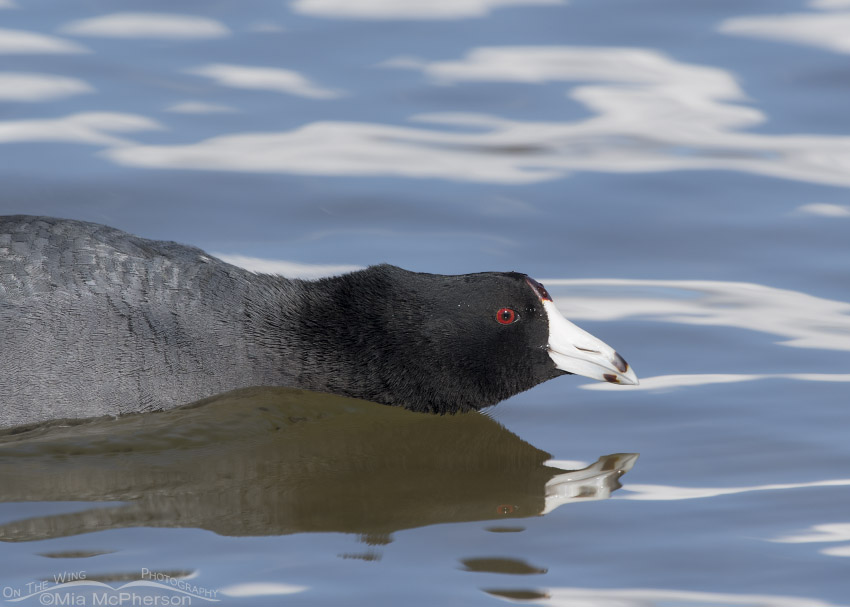 Charging American Coot portrait – Nikon D500, f9, 1/640, ISO 320, Nikkor 500mm VR with 1.4x TC, natural light
Charging American Coot portrait – Nikon D500, f9, 1/640, ISO 320, Nikkor 500mm VR with 1.4x TC, natural light
During late fall, winter and spring I’m able to see and photograph American Coots at my local pond quite frequently and because of that I’m able to observe many of their behaviors including some of their interactions where they communicate to coots and other birds just by using their posture.
One of those postures is called “charging” where the American Coot extends its neck, lowers its head, enlarges its ruff while swimming forward rapidly towards an “intruder”. This behavior is usually exhibited when the coot wants to confront another bird that it feels has invaded its territory. There have been many times that I have observed other birds quickly leave the immediate area when they see a coot charging towards them.
Coots aren’t just territorial during the nesting season, they can also be territorial other times of the year at foraging locations.
I photographed this American Coot in February when parts of my local pond were frozen which caused a restriction in the space where the coots, ducks, geese and grebes could feed and there were many territorial squabbles to photograph. This coot came in close to where I sat in a vehicle using it as a mobile blind, so close that I could only take portraits of this bird.
I know that some bird photographers would take a pass on photographing coots but for me not only do I find their behaviors interesting they are also a challenge to expose properly because of the high contrast between their dark plumage and ivory colored bills. I like challenges and having a bird in my viewfinder is always a good thing.
Life is good.
Mia
Click here to view more of my American Coot photos plus facts and information about this species.
American Coot facts and information:
Fulica americana
- American Coots are chunky chicken-like birds with dark to black bodies, red eyes, white bills with a dark ring, and long greenish yellow legs with long toes.
- In some areas coots are year round residents and in other areas they are migratory. American Coots can be found throughout North America, Mexico and the Caribbean.
- American Coots prefer habitats the include ponds, lakes and marshes. During the winter they can also be found in coastal inlets and bays.
- The diet of American Coots includes aquatic and terrestrial vegetation, aquatic invertebrates, snails, worms and amphibians.
- American Coots lay 2 to 12 eggs which hatch in 21 to 25 days. Both sexes incubate and they are monogamous.
- Nicknames for American Coots include “Marsh Hen” and “Mud Hen”.
- A group of coots can be called a “commotion”, “shoal”, “swarm” and “fleet” of coots.
- American Coots can live up to 22 years.


I suspect I would get out of the way of any bird which looked as determined as that Coot.
Common, shmommon. They are all beautiful and fascinating in my eyes.
I love American Coots! They’re so much fun to watch. This is a fabulous portrait!
We had a mean as hell muscovy duck, I named Bloody Mary. That the Game warden dropped of a at our place…she only liked my younger sister..she used to snake her head and neck out like that just before she attacked the rest of us…she finally attacked a fisherman, he fought her off and killed her.
Çool
I totally agree Mia. Just because the American Coot is a very common bird doesn’t mean they are not both interesting and beautiful. I have watched as they wisely follow Ring-necked and other species of diving ducks on the water surface to collect the morsels that float up when the divers disturb the underwater plants, scurrying around as the diving ducks resurface. They are really fun to watch. I am surprised that you got such a great shot at only 1/640 seconds! Coots are very quick! Beautiful shot!
I would never pass up an American Coot. I used to see them quite often but haven’t for the last couple of years.